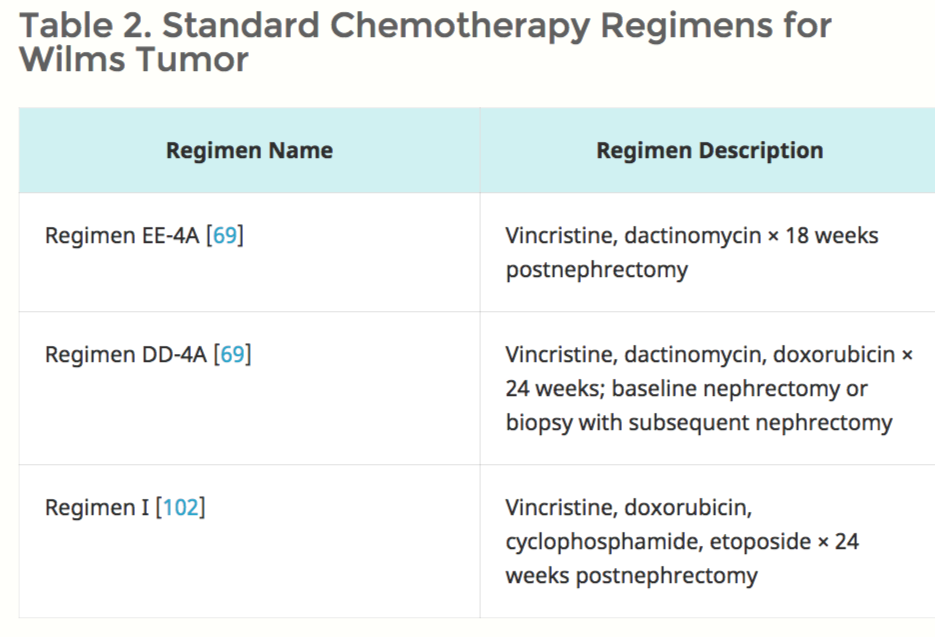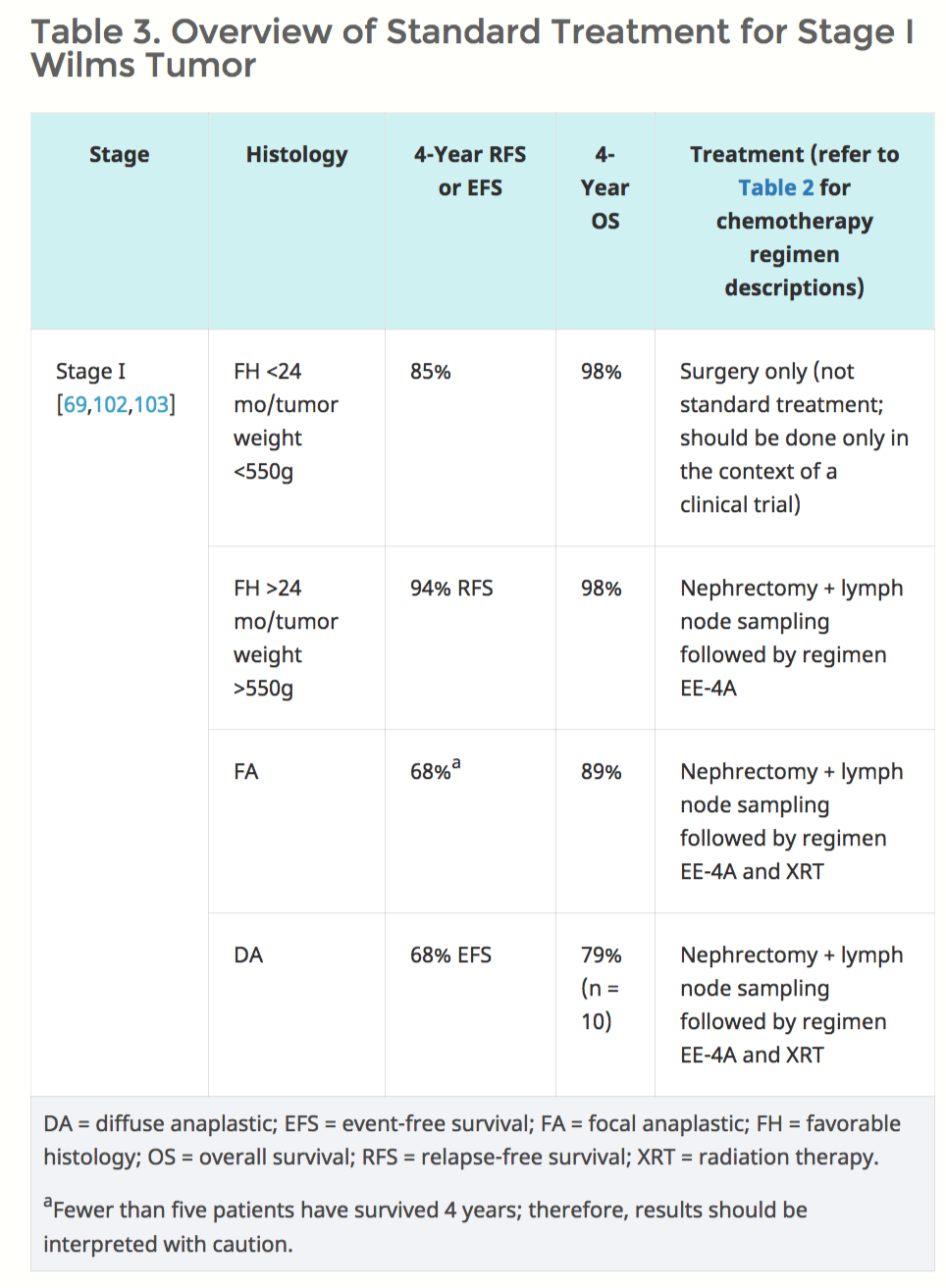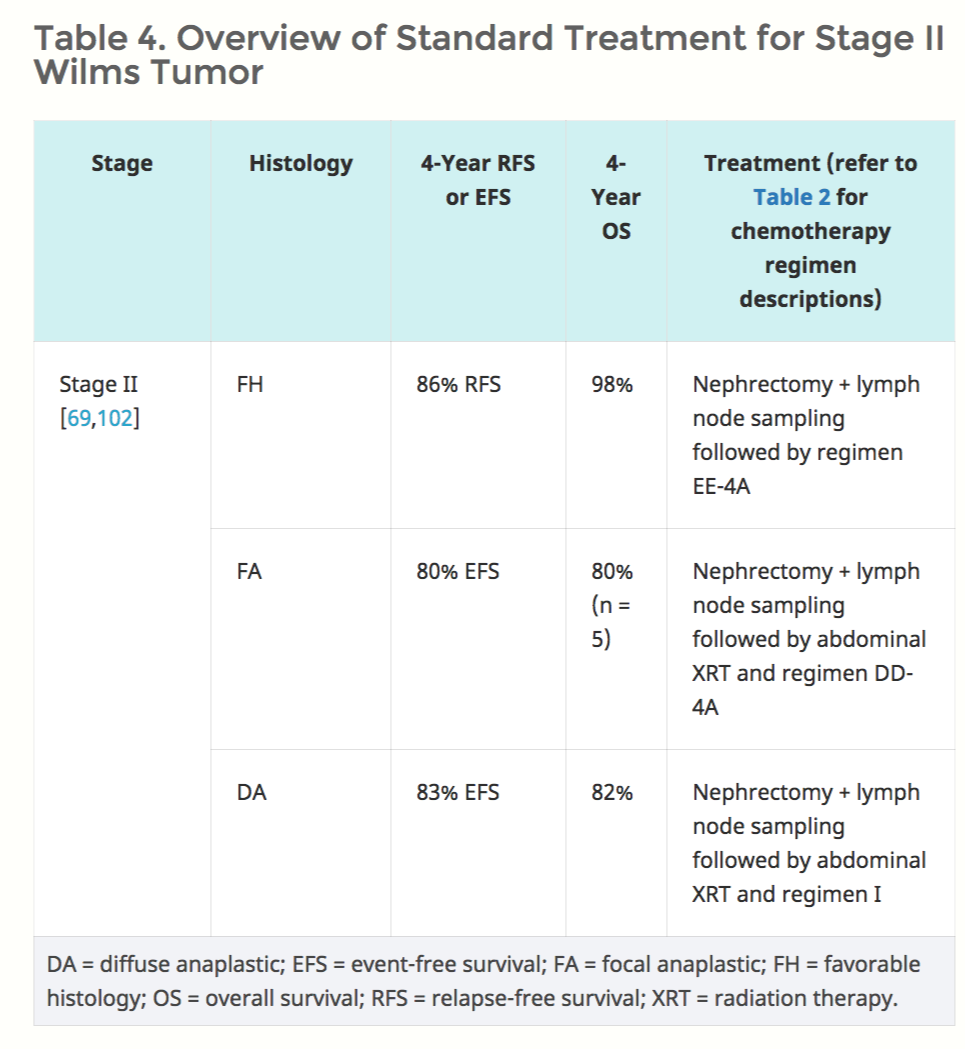Wilms' tumor medical therapy
|
Wilms' tumor Microchapters |
|
Diagnosis |
|---|
|
Treatment |
|
Case Studies |
|
Wilms' tumor medical therapy On the Web |
|
American Roentgen Ray Society Images of Wilms' tumor medical therapy |
|
Risk calculators and risk factors for Wilms' tumor medical therapy |
Editor-In-Chief: C. Michael Gibson, M.S., M.D. [1]
Overview
Medical therapy
This summary focuses on the NWTS (now COG Renal Tumor Committee) results and studies.
The major treatment and study conclusions of NWTS-1 through NWTS-5 (NWTS-1, NWTS-2, NWTS-3, NWTS-4, and NWTS-5) are as follows:
- Routine, postoperative radiation therapy of the flank is not necessary for children with stage I tumors or stage II tumors with favorable histology (FH) when postnephrectomy combination chemotherapy consisting of vincristine and dactinomycin is administered.[127]
- The prognosis for patients with stage III FH is best when treatment includes either (a) dactinomycin, vincristine, doxorubicin, and 10.8 Gy of radiation therapy to the flank; or (b) dactinomycin, vincristine, and 20 Gy of radiation therapy to the flank. Whole abdominal radiation is indicated for extensive intraperitoneal disease or widespread intraperitoneal tumor spill.[127]
- The addition of cyclophosphamide at the protocol dose (10 mg/kg/d for 3 days every 6 weeks) to the combination of vincristine, dactinomycin, and doxorubicin does not improve prognosis for patients with stage IV FH tumors.[127]
- A single dose of dactinomycin per course (stages I–II FH, stage I anaplastic, stage III FH, stages III–IV, or stages I–IV clear cell sarcoma of the kidney) is equivalent to the divided-dose courses, results in the same EFS, achieves greater dose intensity, and is associated with less toxicity and expense.[128]
- Eighteen weeks of therapy is adequate for patients with stage I and II FH, whereas other patients can be treated with 6 months of therapy instead of 15 months.[99,125,128-130]
- Tumor-specific loss of heterozygosity for combined 1p and 16q predicts recurrence of FH Wilms tumor.
There are two schools of thought as to the best therapy for Wilms' tumor. The National Wilms' Tumor Study (NWTS) has been studying this tumor in the United States since 1969. This group recommends surgery as the primary therapy for Wilms' tumor. They have carried out extensive research on this tumor which has been used to guide therapy, as well as to classify tumors into high and low risk groups based on molecular features and to estimate prognosis. [1]
The International Society of Paediatric Oncology in Europe, on the other hand, recommends preoperative chemotherapy to downstage the tumor prior to surgery to reduce the risk of intraoperative rupture of the tumor and dissemination of the malignant cells. A 4 week period of preoperative chemotherapy decreases the risk of intraoperative rupture of the tumor.
Stages I and II
Initial therapy is with vincristine and actinomycin D(dactinomycin) in case of those with favorable histology. In recurrent cases as well as those with unfavorable histology, adriamycin(doxorubicin) is added to the regimen.
Stages III, IV, V Therapy is initiated with vincristine, actinomycin D(dactinomycin) and adriamycin(doxorubicin)
Etoposide, carboplatin and cyclophosphamide are added if necessary. Mesna(sodium 2-mercaptoethane sulfonate) is given with cyclophosphamide.
The current NWTS recommendations are as follows [2]
For tumors with favorable histology:
Stage I and II tumors - 18 weeks of therapy with Dactinomycin + Vincristine
Stage III and IV tumors - 24 weeks of therapy with Dactinomycin + Vincristine + Doxorubicin; as well as radiotherapy to tumor bed and involved sites
For tumors with unfavorable histology: Stage I - 18 weeks of therapy with Dactinomycin + Vincristine
Stages II -IV - 24 weeks of therapy with Dactinomycin + Vincristine + Doxorubicin + Cyclophosphamide + Etoposide; as well as radiotherapy to tumor bed and involved sites
The SIOP recommendations are as follows [2]
Stage I tumors of low grade - no chemotherapy necessary
Stage I tumors of intermediate grade or showing anaplasia - 18 weeks of therapy with Dactinomycin + Vincristine
Stage II without lymph node involvement - 28 weeks of therapy with Dactinomycin + Vincristine + Epirubicin
Stage II with lymph node involvement and Stage III - 28 weeks of therapy with Dactinomycin + Vincristine + Epirubicin; as well as radiotherapy to tumor bed
High grade tumors - 34 weeks of therapy with Epirubicin + Ifosfamide + Etoposide + Carboplatin; as well as radiotherapy
Stage IV (metastatic) - as per the appropriate local stage of the tumor; as well as treatment of metastases by surgery or radiotherapy
Recurrent tumors
ifosfamide, etoposide and carboplatin may be used.
Chemotherapy
Preoperative chemotherapy before nephrectomy is indicated in the following situations:
- Synchronous bilateral Wilms tumor.
- Wilms tumor in a solitary kidney.
- Extension of tumor thrombus in the inferior vena cava above the level of the hepatic veins.
- Tumor involves contiguous structures whereby the only means of removing the kidney tumor requires removal of the other structures (e.g., spleen, pancreas, or colon but excluding the adrenal gland).
- Inoperable Wilms tumor.
- Pulmonary compromise due to extensive pulmonary metastases.



References
- ↑ http://www.nwtsg.org/about/about.html
- ↑ 2.0 2.1 Sushmita Bhatnagar (2009 Jan-Mar;). "Management of Wilms' tumor: NWTS vs SIOP". J Indian Assoc Pediatr Surg. Medknow Publications. 14: ((1)): 6–14. doi:doi: 10.4103/0971-9261.54811 Check
|doi=value (help). PMC PMCID: PMC2809467 Check|pmc=value (help). PMID [PubMed 20177436[PubMed]] Check|pmid=value (help). Check date values in:|date=(help)